| |
      |
| |
|
Information from our earlier website |
|
The whooshes, flashes, booms and bangs of Guy Fawkes Night aside, which being a bloke who has never actually grown up I cannot deny that I enjoy, November is usually a month that holds little appeal for me. The Christmas holidays aren’t quite within reach and the world championship MotoGP motorcycle has ended for the year = misery. Well … that’s what I usually think, but being an illustrator, and having attended the Dunedin School of Art’s SITE art exhibition this year, I may well have had a change of heart. Held in the last third of November, the SITE exhibition of graduate students’ work is simply art fireworks! So-much-so that I had to have two goes at viewing it and, having done that, I could still have gone back for more. SITE is a labour of love for Professor Leoni Schmidt and Rachel Allen who, between them, spend untold numbers of hours organising the placement of the hundreds of works of art, while soothing the fevered brows of stressed students striving to add that last “it will make all the difference” nuance to their creations in time for opening day.
The Otago Masonic Charitable Trust involvement is through their administration of the Fred Staub Open Art initiative on behalf of the Dunedin School of Art Foundation. Fred Staub Open Art has led to the art school being capable of funding visits and public demonstrations by artists and lecturers, travelling from around the world, in a way that it would not have been capable of doing prior to our involvement.
SITE showcases up-and-coming artists’ talent and it is refreshing to see just how much actual talent there is in little not-so-old New Zealand. Even better when it chooses to display itself in Dunedin. Leoni Schmidt and the Dunedin School of Art kindly gave the Otago Masonic Charitable Trust permission to display herein a few of the wonderful works of art on offer and we hope that you will enjoy them too.
Textiles
The only objects that Susan Nunn did not sew, in this double-take creation of an uncleared dinner table, were the chairs and table – they were wooden. As for the remainder? Every item was itself a work of art. Knives – sewn. Forks – sewn. Dominos pizza boxes and the half-eaten pizza therein – sewn. As a man entirely incapable of successfully darning a sock, I thought that her work was stunning. |
| |
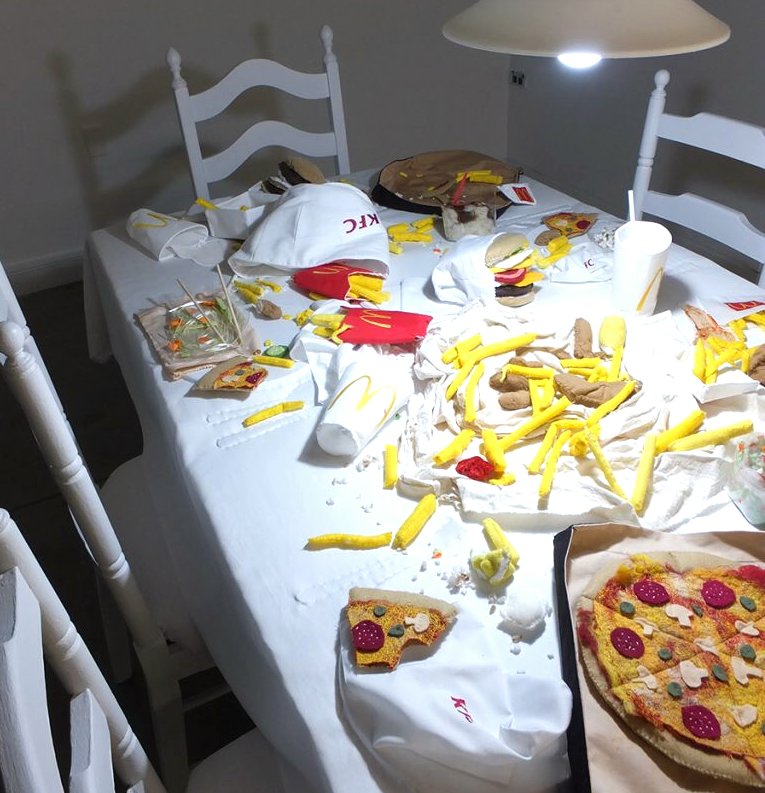
|
|
A view of Susan Nunn’s ‘After Dinner’, which is an indictment on fast food’s encroachment into leisurely family dinners, causing these to become a thing of the past |
|
| |
Susan was hypothesising on the transformation that she believes has taken place in family eating habits caused by the proliferation of fast food outlets. In this work Susan intimates that leisurely-dinner-around-the-table with family has (or may) become a thing of the past. Probably no fanciful idea either. Certainly her lifelike hand-sewn McDonald’s cartons, KFC wrappers and even a humorous hand-sewn grease stain on the table cloth are a sure fire way to ensure that the casual observer will take notice of any future musing she cares to make public. |
| |
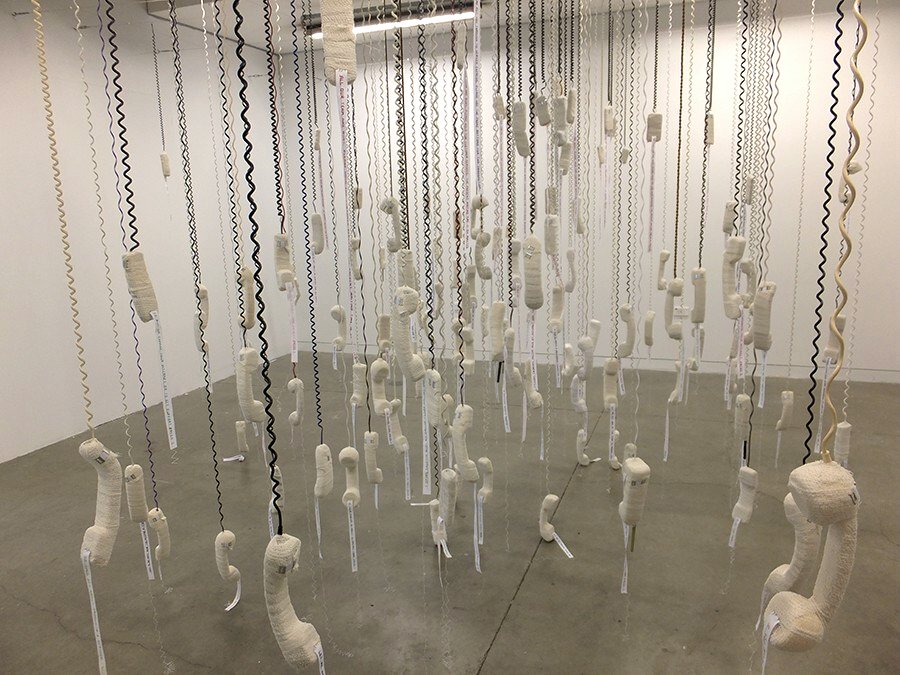
|
|
‘Help Me’ was created with desperation reflecting Megan Griffiths’ utter frustration with off-shore call centre inefficiencies. |
|
‘Help Me’ is a cri de coeur from Megan Griffiths expressing her utter frustration when attempting to glean worthwhile medical information via helpdesk call centres. Most of us have suffered long hours of fruitless waiting on a telephone – the droning, inane, background muzak ensuring that our wait is palpably painful – so we can only have sympathy for her. Even more so, when we learn that she was attempting to elicit much needed assistance for her father who had been stricken with Alzheimer’s disease.
Griffiths’ Dali-esque concept of dozens of stark, white, unanswered, dangling telephones, swathed in bandages make a powerful indictment of offshore call centre systems when one is privy to the sad background to her work.
Printmaking
|
| |
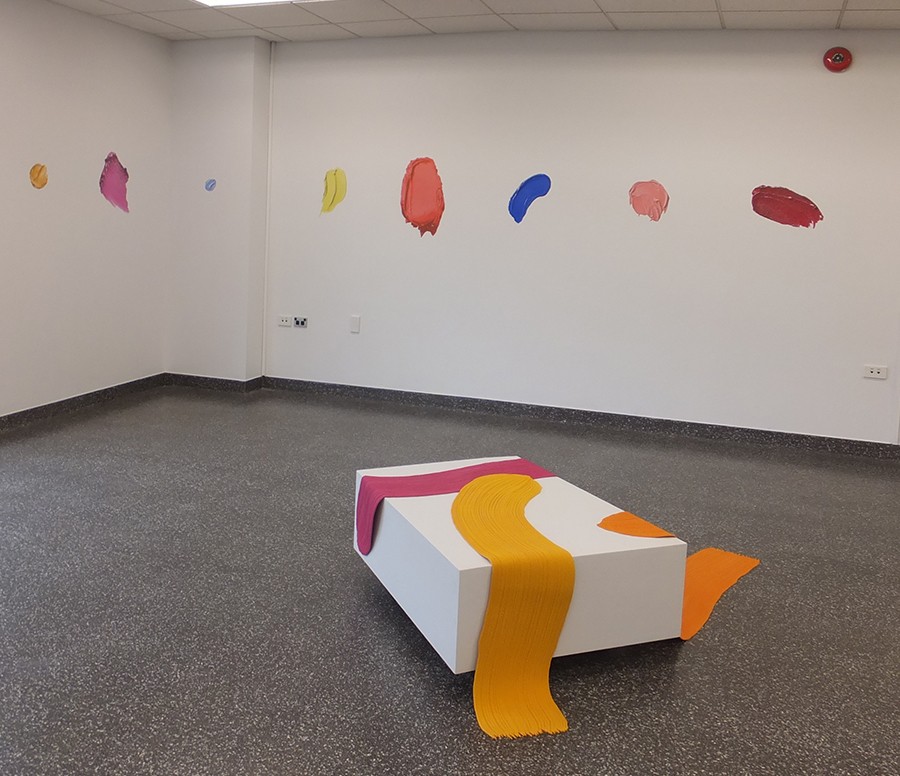 |
|
Do Not Touch! the sign said to visitors in the gallery – but Sophie McDonagh’s series ‘Brushstroke’ was so lifelike that most people just had to check her creations out to be sure. |
|
‘Brushstroke’ – Sophie McDonagh
McDonagh’s ‘Brushstroke’ series in cast latex inspired exhibition visitors to do the touchy feely thing – and they justly obliged. Any artist can be proud if they have perfect strangers react positively to their creations and Sophie succeeded. A visitor exclaimed, “Wow! These look real.” Sophie’s very original, enjoyable art was evidenced by the fact that all the pieces in her series ‘Fake/Found’ were sold. She only needs to repeat this process through her life and success in her chosen career is assured.
Jewellery
|
| |
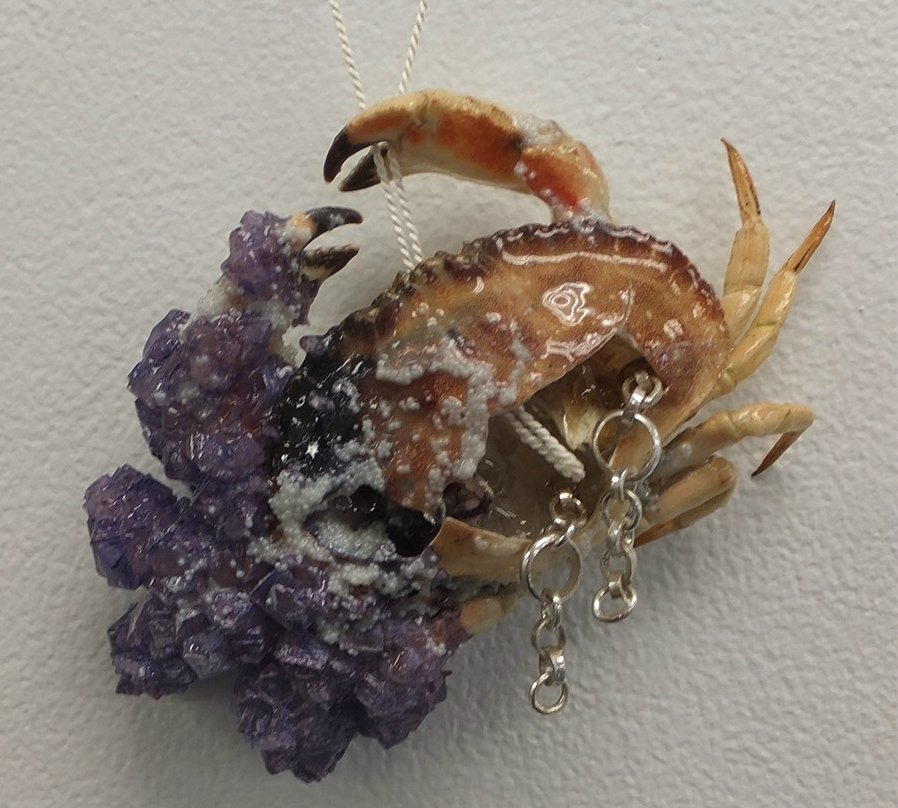 |
|
An extraordinary conglomeration of materials makes for truly extraordinary jewellery as in this piece, ‘Tyrian Crab’ by Meg van Hale. |
|
Meg van Hale
‘Tyrian Crab’ by Meg van Hale provided a superb example of jewellery making at its best. Utilizing an extraordinary conglomeration of materials, crab shells, borax crystals, silver metal, silk, beads and resin Meg produces jewellery of exquisite quality. One example was an outstanding piece; much too delicate to wear, it really should be behind glass. Should you get the overwhelming urge to purchase one of her amazing creations, it will not be a decision you would regret.
Jewellery & Metalsmithing |
| |
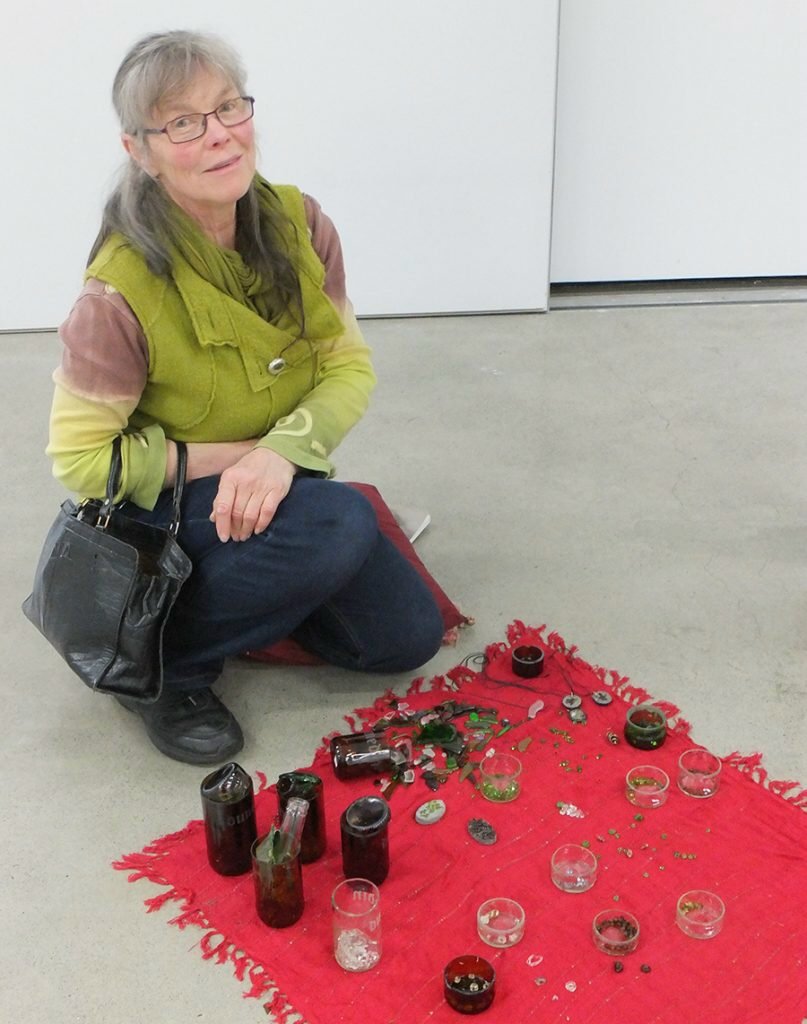 |
|
Jeweller Alison Wallace says that she attempts “to make beautiful jewellery out of discarded trash.” Though no owner of her work would wish to discard her captivating creations. |
|
Alison Wallace
Alison Wallace had a large number of her glittering pieces on display in her ‘Hide and See’ presentation. Hers was almost an exhibition within the exhibition. She says that she seeks to create beautiful wearable jewellery from discarded trash. She had so many alluring pieces on show that, in that aim, this metalsmith has assuredly succeeded.
Painting |
| |
 |
|
It’s not such an easy task to capture “youth” or “young age” within a portrait, but Chelsea Hayes manages well in this loosely rendered oil. |
|
Chelsea Hayes
If Chelsea Hayes is considering earning her salt by portrait painting then she is well on the way to achieving that goal. Her array of confidently rendered portraits dominated the space in the main gallery on the first floor.
|
| |
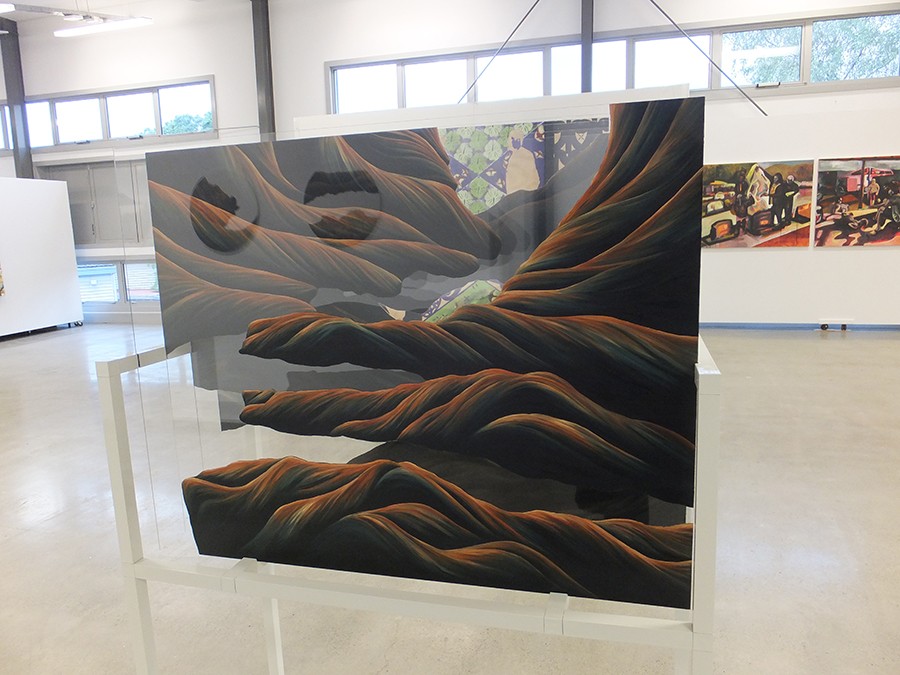
“Otago Landscapes” by Jemma Russell.
Acrylic on Perspex. |
|

The entwining movement artist Jemma Russell employs injects her work with a sensual quality. |
|
Jemma Russell
Using oil or acrylic paint on clear Perspex is not a new art form but Jemma Russell’s treatment of her landscapes ‘Otago Landscapes’ and ‘Otago Coast’ melded the style of Rita Angus with the flowing movement of van Gogh’s images of ‘The Starry Night’. These were yet more commendable, attention-grabbing works from a young Dunedin School of Art graduate.
|
|
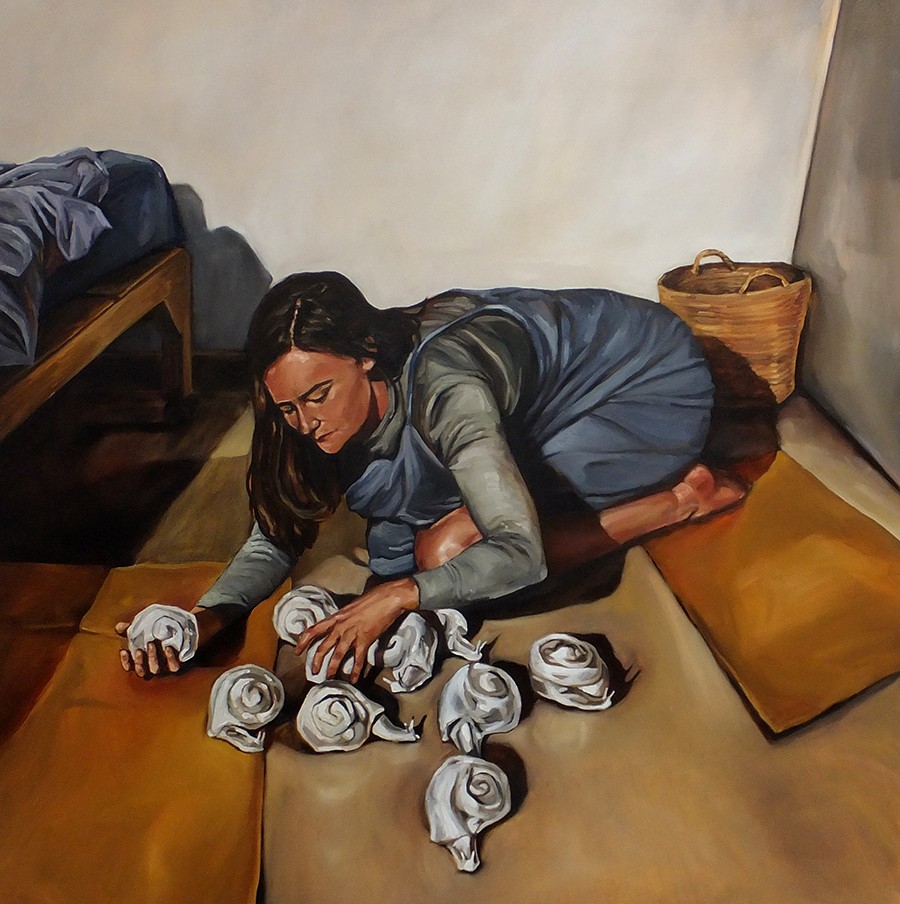
It is difficult to do justice to the size of her paintings, but large canvases by Madison Kelly towered over the main entrance to the Dunedin School of Art’s ‘SITE’ exhibition. |
|
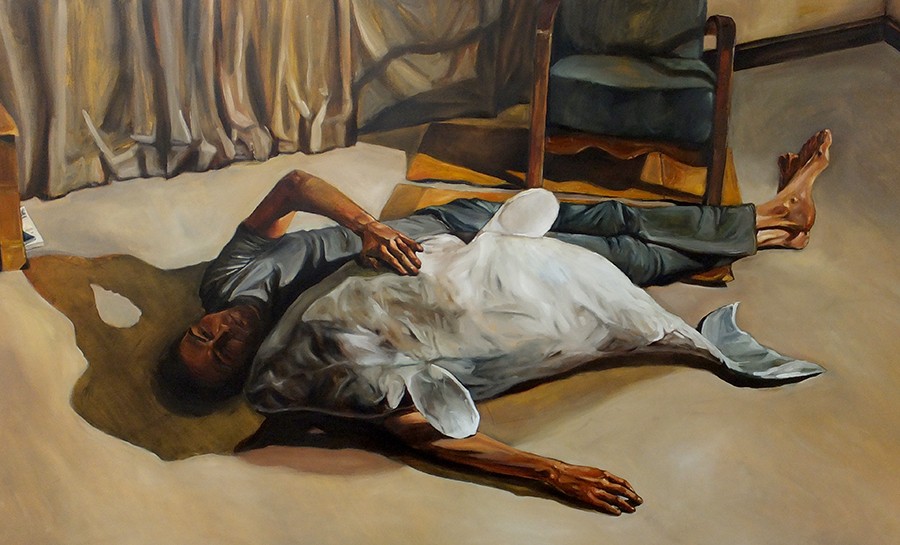
Confidently rendered in oil on canvas, Madison Kelly’s self-assured drawing skills are equally complimented by her ability as a painter. |
|
Madison Kelly
Towering compelling works by Madison Kelly commanded the main entrance to the SITE exhibition. For anyone remotely interested in painting it would have been a wrench to progress much further, so absorbing were Madison’s works ‘Maunganui Bluff’, ‘Scattered Sites’ and ‘Tiny Pockets’. Painted swiftly by someone confident in their touch the oils brought to mind the work of Deidre Copeland.
It would be hard to believe that there is not a bright future ahead for Madison Kelly.
Painting / Print
|
| |
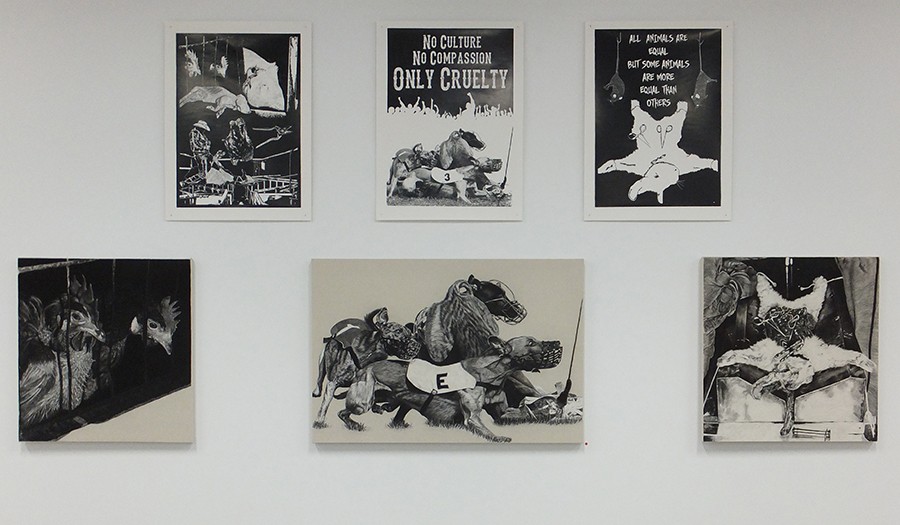 |
|
These skilfully rendered, stark, monochromatic prints by artist Daniel Bloxham placed the subject of animal cruelty firmly in the face of visitors to ‘SITE’. |
|
|
Daniel Bloxham
Unnerving monochromatic images brought the subject of cruelty to animals to the fore through five works by Daniel Bloxham. His powerful prints certainly prove the point that art can influence thought. Just as Francisco Goya’s ‘Third of May’ and Picasso’s ‘Guernica’ are two of the most influential anti-war images of all time, so Daniel Bloxham seeks to emulate their impact, his works at once highlighting and condemning cruelty toward defenceless animals, an abhorrent practise that Daniel is dedicated to eradicating.
Sculpture |
| |

If sculptor Jerry S. Howlett was attempting to creep-out his audience then he completely succeeded with this massive, macabre creation. |
|
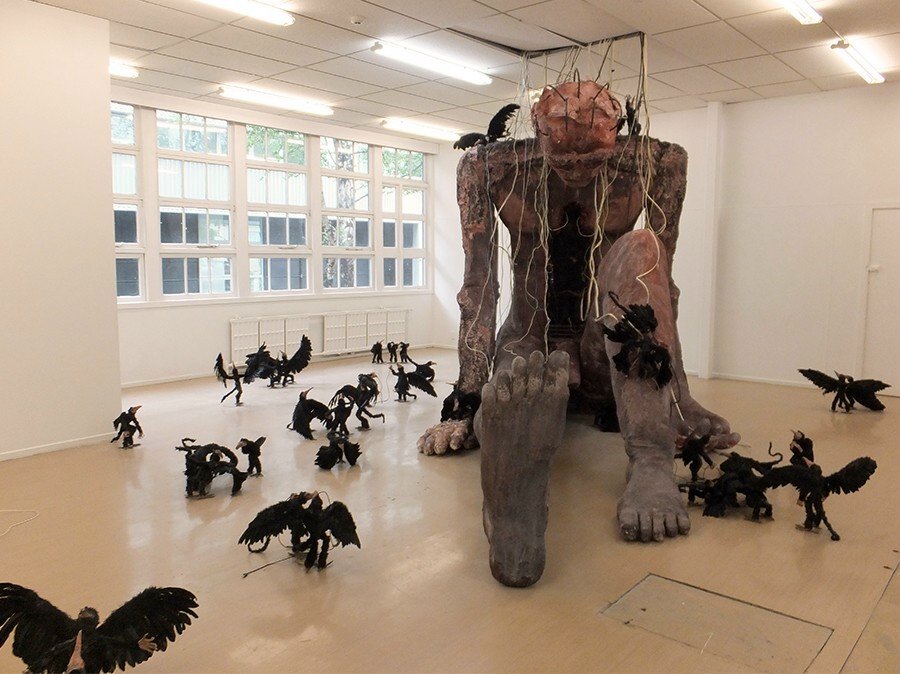
The detail in the disturbing sculpture ‘Prometheus Bound’ compelled visitors to return again and again. Though it is certain they would have fled if the lighting had failed! |
|
|
‘Prometheus Bound – Cathartidae Unchained’ – Jerry S. Howlett
“Did I request thee, Maker, from my clay
To mould me man? Did I solicit thee
From darkness to promote me?”
Borrowed from John Milton’s ‘Paradise Lost’ this quotation introduces Mary Shelley’s Gothic novel Frankenstein; or The Modern Prometheus, and could be easily utilized as the epigraph for Jerry S. Howlett’s immense sculpture. ‘Prometheus Bound – Cathartidae Unchained’ is a monumental work that dominated the external southern gallery of the Dunedin School of Art. Howlett’s creation appears to depict the God Prometheus being brutally persecuted, not by the eagle of mythology, but by flocks of vultures (cathartidae), presumably sustained (if we follow the Grecian chronicles) by eating the raw flesh of his liver. (My apologies if you were half-way through your lunch.)
The sculpture is gross, in several senses of the word, but nevertheless it is mesmerizing, compelling the viewer to return to look upon it again in attempts to make sense of its concept. Entangled in yards of electric cable, the sculpture appears to reflect the Frankenstein monster of the films, indeed Jerry S. Howlett could have easily re-titled his work, ‘Prometheus: The Modern Frankenstein’.
|
| |
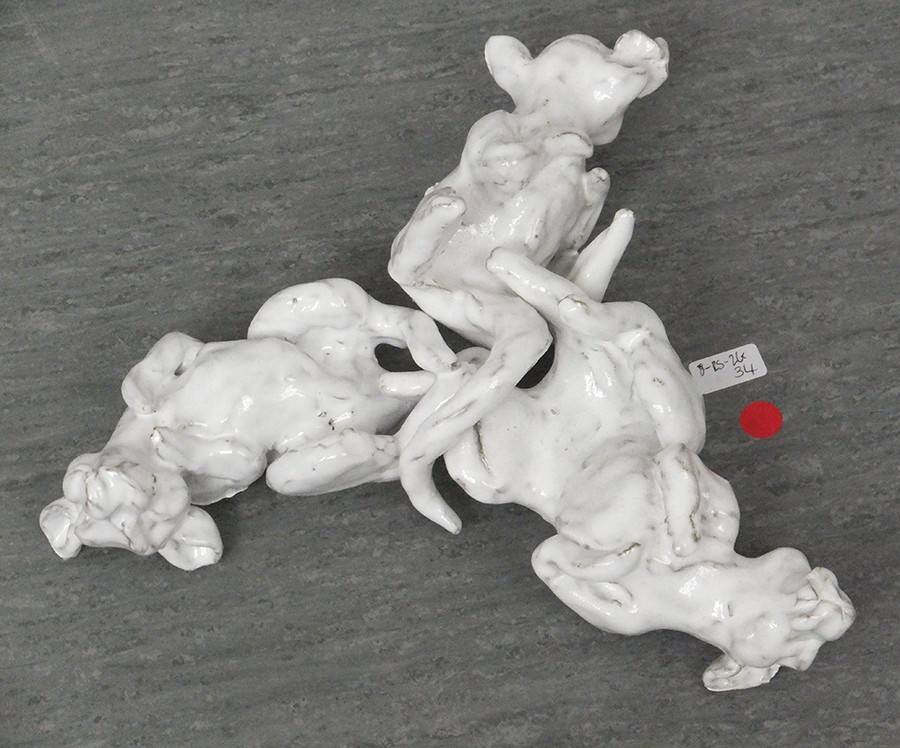
. |
|
The spectacularly named sculptor Rata Scott von Tippelkirch certainly wowed the crowd with variants of these amusing and delicately crafted figurines of dogs at play. All the pieces on show being snapped up by buyers. |
|
Rata Scott von Tippelkirch
Small porcelain figurines of dogs playing and wriggling together on the ground were a definite hit with visitors to the SITE exhibition. Conjured from the imagination of artist, Rata Scott von Tippelkirch, the works were at once intriguing, compelling, attractive, complex and, more importantly, popular, all having been sold at the event. We are likely to see much more from this spectacularly named sculptor.
Mixed Media |
| |
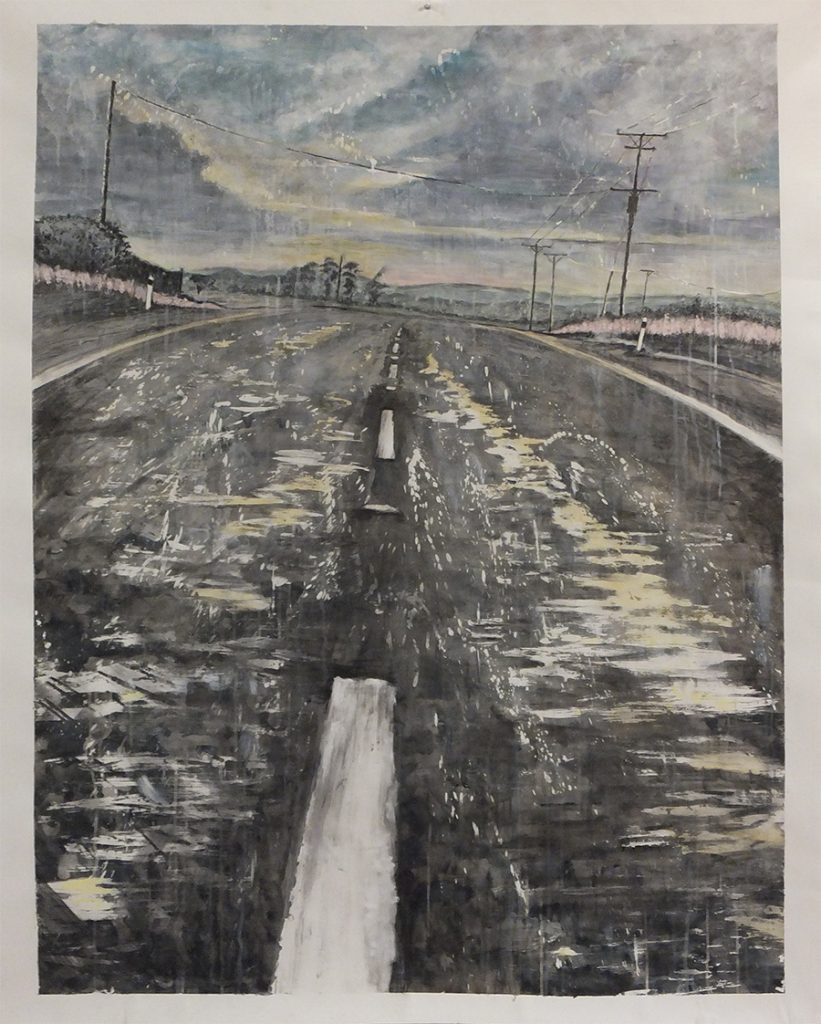
The loosely rendered illustration of a rainswept road by artist Craig Cook packs his painting with movement. |
|
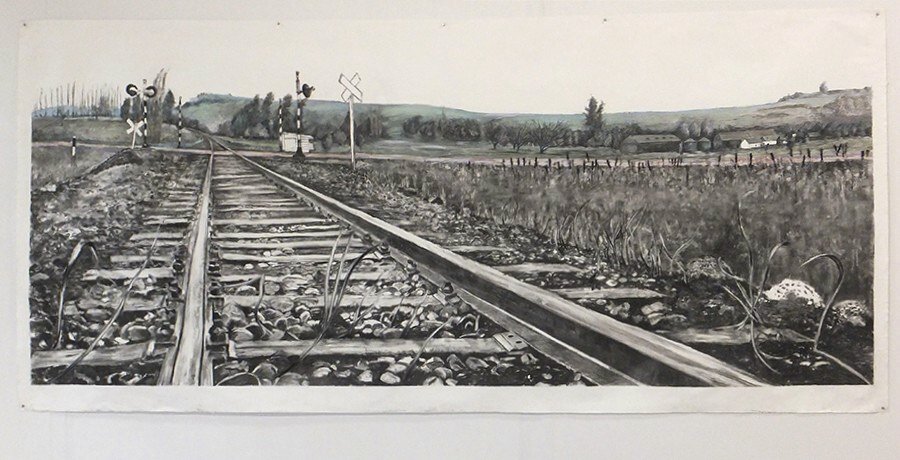
Through quick rendition artist Craig Cook is able to imbue his work with great movement; quite a feat when one considers that his subject is basically a landscape! |
|
|
Liminal Illuminations – Craig Cook
Dunedin School of Art’s SITE 16 was simply a terrific exhibition of new artistic talent. It is a tribute to the organisers Leoni Schmidt and Rachel Allen as much as to their students and if you ever get the opportunity to visit do not miss it. I can add nothing more except to say, “roll-on November!”
John Wren-Potter
|
NOTES:
Fred Staub
Frederick Charles William ‘Fred’ Staub (1919 – 2012) – Fred Staub was a well-known Otago artist, art educator and dedicated Freemason. He worked at the Dunedin School of Art for 26-years between 1951 and 1977. Works by Fred are spread across the city of Dunedin. The iconic ‘History’ and ‘The Thread of Life’ perched on Signal Hill were designed by the then elderly Lancastrian, Francis Aubrey Sturrock, who had previously been Fred Staub’s art teacher and had taught him to sculpt. Although it was a joint effort, it was through Fred’s considerable input, that the works were realized, as the construction of the figures was a complex business, requiring models of the statues to be scaled up from half-size to full-size, and then dispatched to England to be cast in bronze. Completed in May 1957, both men’s names appear on the finished monuments that are now enjoyed by the citizens of the City and visitors alike.
In his Will Fred Staub bequeathed a substantial amount to New Zealand’s Otago Masonic charitable Trust to be used for the purpose of art education and thus the Fred Staub Open Art initiative was established. Funds are gifted twice annually to the Dunedin School of Art Foundation aimed at promoting engagement with art in the Otago community. Today Fred Staub Open Art supports a programme of public seminars and exhibitions.
Professor Leoni Schmidt
This particular SITE exhibition proved to be Leoni Schmidt’s swan song as, following seven-years as Head of the Dunedin School of Art, she transitioned into the post of Director of Research and Postgraduate Studies at Otago Polytechnic. The Trustees and members of the Otago Masonic Charitable Trust wish her well in her new rôle and thank her for her sound advice and for the enthusiasm with which she greeted the implementation of the Fred Staub Open Art fund.
|
|
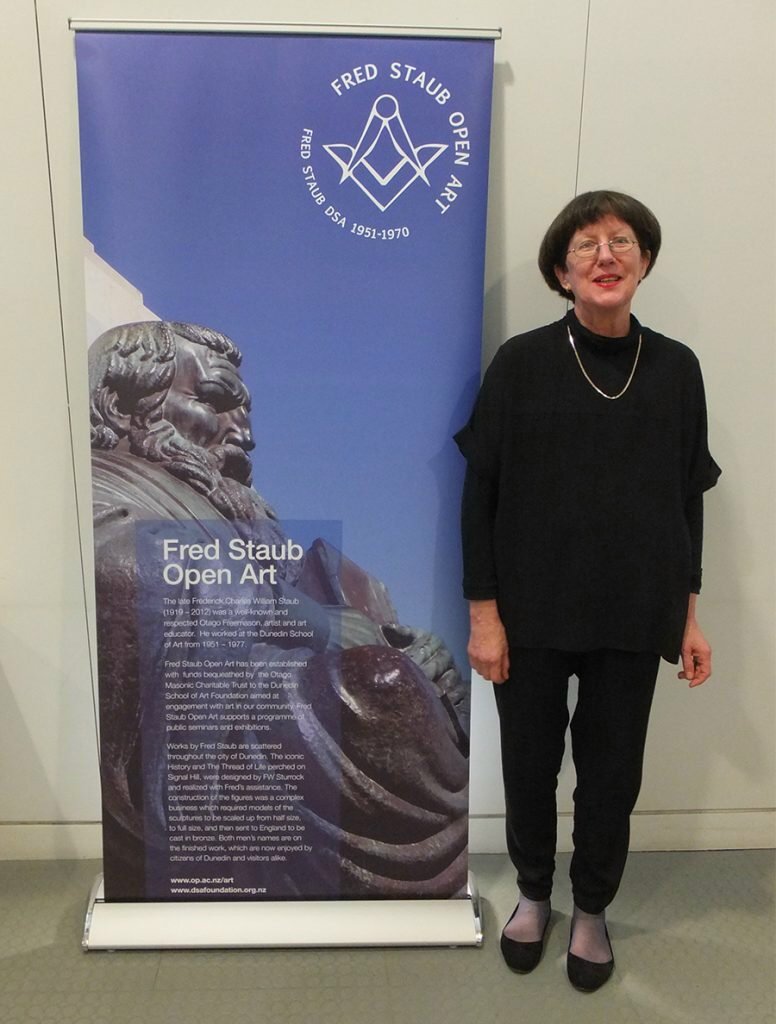
Professor Leoni Schmidt |
|
|
| OMCT website by Worsfold Software Ltd, Alexandra |

